Home
Plants
Cinnamon
I was sitting at the table
the other night drinking a mug of hot apple cider with a cinnamon
stick and wondering where cinnamon came from. Actually, cinnamon is
nothing like I envisioned.
Actually, cinnamon is the inside bark of the
tropical evergreen laurel tree native to Sri Lanka (formerly known as
Ceylon.) At the right is the small stem of the plant. 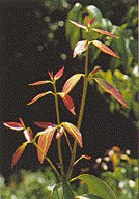
Sri Lanka's most important export is cinnamon. In
fact, so strong is the affinity between cinnamon and Sri Lanka that
the very botanical name of the spice - Cinnamomum zeylanicum is
derived from the island's former name, Ceylon. Sri Lanka is the
world's leading source of cinnamon, producing not only four-fifths of
the world output but its choicest grades as well. The spice is
derived from the sweetly scented inner bark of the cinnamon tree,
whose habitats are verdant tropical locations such as Indonesia, the
Malabar coast of India, the Seychelles, the West Indies and, more
recently, tropical South America. Its use as a spice is of great
antiquity and was known in ancient Egypt and is mentioned in the Old Testament.
The bark is harvested twice a year, starting when
the trees are about three years old, one year after pruning. Cinnamon
is always harvested immediately after
each of the two rainy seasons, when the rain-soaked bark can be more
easily stripped from the trees.
Cinnamon peeling is a highly skilled technique,
handed down almost unchanged from ancient times. In Sri Lanka it is
still the exclusive occupation of the Salagama caste - a
socio-occupational group which follows a trade prescribed by
tradition, and quite separate from the growers.
In the first stage of the harvest, the
"flush" of tender shoots is cut down and, covered in
sacking in the peeling shed, left to ferment lightly.
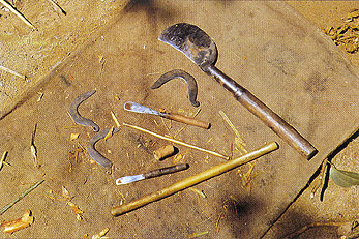 The
most difficult part of cinnamon production starts the next day.
Seated on the floor of the
The
most difficult part of cinnamon production starts the next day.
Seated on the floor of the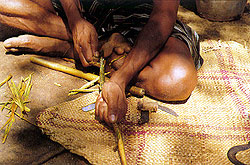 peeling shed, the peelers snip off the leaves and twigs, and scrape
off the rough outer bark from the twigs. The inner bark is then
rubbed and beaten down thoroughly with a smooth brass block to break
up and homogenize the tissues and free the bark from the twigs. Then
the peeler, using the distinctive tool of his trade, a small curved
knife called a kokaththa, deftly marks two parallel slits on the
stick and eases the bark free in one piece. Experienced peelers do
this swiftly and with the precision of a surgeon, making clean and
true cuts - all without fragmenting the bark.
peeling shed, the peelers snip off the leaves and twigs, and scrape
off the rough outer bark from the twigs. The inner bark is then
rubbed and beaten down thoroughly with a smooth brass block to break
up and homogenize the tissues and free the bark from the twigs. Then
the peeler, using the distinctive tool of his trade, a small curved
knife called a kokaththa, deftly marks two parallel slits on the
stick and eases the bark free in one piece. Experienced peelers do
this swiftly and with the precision of a surgeon, making clean and
true cuts - all without fragmenting the bark.
Next, the barks are carefully packed in layers, one inside the
other, in several plys, telescoped and overlapped end to end to
produce long, rolled and layered "quills."
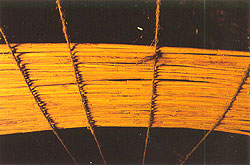 The
bark rolls are covered in jute sacking again and left to cure
lightly for a day, after which they are air-dried indoors on hammocks
for two days. When dried, the bark is curled round into golden-brown
quills, which are again dried outdoors in filtered sunlight for one
or two days. By this time the cinnamon is dried to a crackling,
papery texture and possesses the true cinnamon color.
The
bark rolls are covered in jute sacking again and left to cure
lightly for a day, after which they are air-dried indoors on hammocks
for two days. When dried, the bark is curled round into golden-brown
quills, which are again dried outdoors in filtered sunlight for one
or two days. By this time the cinnamon is dried to a crackling,
papery texture and possesses the true cinnamon color. 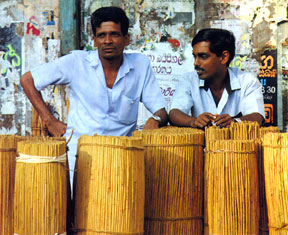 The
bark is then trimmed precisely to the 42-inch quills specified by
the world cinnamon market.
The
bark is then trimmed precisely to the 42-inch quills specified by
the world cinnamon market.
Growers journey to the fair with their cinnamon,
all processed and baled to the precise requirements of the London and
Amsterdam transshipment trade. Each grower's peelers also attend the
fair, and according to an age-old practice, their proceeds are
divided equally between them. This is a highly effective quality
control: the peelers maintain high standards in processing the bark
since their share depends as much on the caliber of their work as on
the natural quality of the cinnamon.

 The
most difficult part of cinnamon production starts the next day.
Seated on the floor of the
The
most difficult part of cinnamon production starts the next day.
Seated on the floor of the peeling shed, the peelers snip off the leaves and twigs, and scrape
off the rough outer bark from the twigs. The inner bark is then
rubbed and beaten down thoroughly with a smooth brass block to break
up and homogenize the tissues and free the bark from the twigs. Then
the peeler, using the distinctive tool of his trade, a small curved
knife called a kokaththa, deftly marks two parallel slits on the
stick and eases the bark free in one piece. Experienced peelers do
this swiftly and with the precision of a surgeon, making clean and
true cuts - all without fragmenting the bark.
peeling shed, the peelers snip off the leaves and twigs, and scrape
off the rough outer bark from the twigs. The inner bark is then
rubbed and beaten down thoroughly with a smooth brass block to break
up and homogenize the tissues and free the bark from the twigs. Then
the peeler, using the distinctive tool of his trade, a small curved
knife called a kokaththa, deftly marks two parallel slits on the
stick and eases the bark free in one piece. Experienced peelers do
this swiftly and with the precision of a surgeon, making clean and
true cuts - all without fragmenting the bark. The
bark rolls are covered in jute sacking again and left to cure
lightly for a day, after which they are air-dried indoors on hammocks
for two days. When dried, the bark is curled round into golden-brown
quills, which are again dried outdoors in filtered sunlight for one
or two days. By this time the cinnamon is dried to a crackling,
papery texture and possesses the true cinnamon color.
The
bark rolls are covered in jute sacking again and left to cure
lightly for a day, after which they are air-dried indoors on hammocks
for two days. When dried, the bark is curled round into golden-brown
quills, which are again dried outdoors in filtered sunlight for one
or two days. By this time the cinnamon is dried to a crackling,
papery texture and possesses the true cinnamon color.  The
bark is then trimmed precisely to the 42-inch quills specified by
the world cinnamon market.
The
bark is then trimmed precisely to the 42-inch quills specified by
the world cinnamon market.